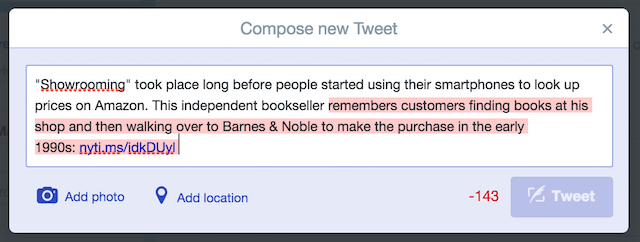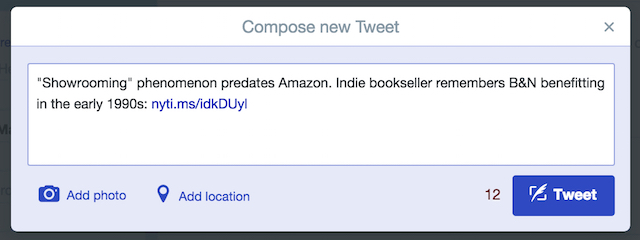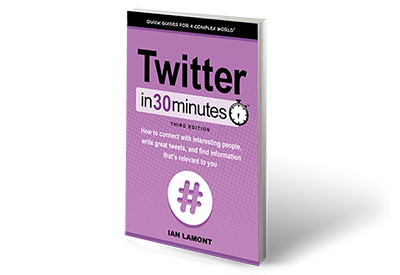Using the new 2019 Twitter interface, learn how to browse for and add an animated GIF using Twitter’s built-in tool in the browser version of Twitter. Narrator Ian Lamont is the publisher of the In 30 Minutes guides, including Twitter In 30 Minutes.
Using the new 2019 Twitter interface, learn how to check your Twitter analytics for individual tweets and the entire account. Narrator Ian Lamont is the publisher of In 30 Minutes guides, including Twitter In 30 Minutes.
Stop or reduce the email notifications you receive in your email inbox by changing settings on Twitter.com. In four minutes, learn how to pare down the Twitter email notifications such as tips or meaningless notifications. There are, however, a few types of notifications that you might want to receive as email notifications. Narrated by the author of Twitter In 30 Minutes.
Do you want to block certain people or accounts on Twitter? In just over three minutes, learn how to use Twitter’s “Block” feature on Twitter.com to block people, advertisers, or other types of accounts from following you or appearing in your notifications. Narrated by Ian Lamont, the author of Twitter In 30 Minutes.
Sick of certain topics, phrases, and hashtags showing up in your Twitter feed? In three minutes, learn how to use Twitter’s “Muted Words” feature to select certain words to exclude, the source of the word/phrase to exclude, and how long that word or phrase is muted from Twitter. Narrated by Ian Lamont, the author of Twitter In 30 Minutes.
Change the trends that show up next to your Twitter feed on Twitter.com. In less than three minutes, learn how to use the “Change Trends” feature to shift the “trending” topics that show up next to your feed, which are often based on what people in your city or country are Tweeting about, even if you have no interest in them. Narrated by the author of Twitter In 30 Minutes.
Want to block certain people or accounts on Twitter? In just over 3 minutes, learn how to use Twitter’s “Block” feature on Twitter.com to block people, advertisers, or other types of accounts from following you or appearing in your notifications.
I recently received a message from a reader on the topic of operating multiple Twitter accounts. This reader asked if it was a good idea to have more than one Twitter account:
I just finished your book on Twitter in 30 Minutes, and found it to be extremely helpful! You do a great job of making a daunting topic simple! I do have one question: I set up a second account because my life is bifurcated between an educational consulting practice and my family. I plan to finally use Twitter far more effectively than I have done in the past. Am I making a mistake to have two accounts with very different sorts of tweets between them?
My answer: No, it’s not unusual for people to run multiple accounts with different focuses. I have four or five active accounts, including my personal @ilamont, my business @in30minutes and a few other topic areas that interest me. Sometimes I retweet between them if there is overlapping interest.
One thing I would do, however, is make the handles different. If you have two very similar twitter handles based on your name, this may confuse some people who are searching for you, or friends who are recommended to follow you, but are not sure of the right account. So, one account could be @johnsoneducation and the other @johnsoninKC.
The other tip is to start using Tweetdeck (tweetdeck.twitter.com) a Twitter operated Web tool which lets you manage more than one account at a time.
In this 6-minute Twitter tutorial, learn how to turn off some or all Twitter notifications using the Twitter Web interface or the Twitter mobile app (iPhone is shown, but process is similar for the iPad). The narrator of the Twitter tutorial is Ian Lamont, the author of Twitter In 30 Minutes.
I received an email from a reader asking about keeping tweets under 140 characters. Here’s what he said:
“Just finished your book and hopefully set up an account. Think I successfully set. up my first tweet. One question. First draft too long. I couldn’t figure out how to get help to cut it down. Just backspaced and deleted words. Is there another way? Thanks for your great treatise.”
It’s actually a common problem, and one that I deal with every day. I like to express thoughts that may take a whole sentence and use “normal” English grammar, but Twitter is unforgiving — anything over 140 characters will be cut off upon posting. Fortunately, Twitter shows how many characters remain (or are over the limit), which makes figuring out the proper length a little easier.
Here’s what I wrote back:
Thanks for your email! There’s no magic way to cut a tweet down to 140 characters. I usually get very creative with shortcut words (e.g. & instead of and, w/ instead of with, intl instead of international) and drop pronouns. I have also seen people break a long tweet into two tweets, like this:
1. Love how the waiter at Joe’s Italian Bistro took the time to explain how they braise lamb chops2. Definitely plan on going there again for our anniversary!
I also discussed this issue in Twitter In 30 Minutes, and showed an example of how to creatively cut down a long tweet to the right length. Here’s the long version:
Here’s the short version:
Keep in mind that links, photos, and hashtags will add to the character count, so you need to leave room for those elements if you want to include. them.
One other thing worth noting: I always try to leave at least 13 characters remaining. Why? Because it makes it possible for anyone to retweet my message without going over (“RT @ilamont: ” requires 13 characters.


